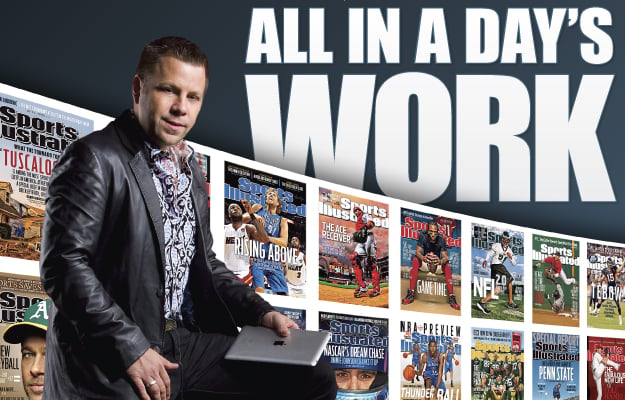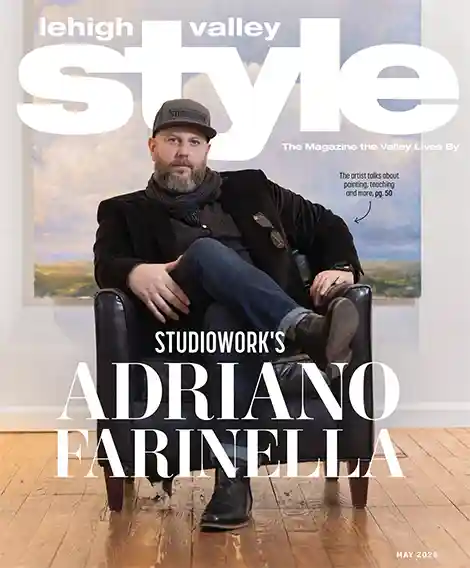The Super Fan: Christopher Hercik
Creative Director, Sports Illustrated magazine
“Oh, yeah,” is Christopher Hercik's emphatic response when asked if his job is really as amazing as it sounds. It's not an unexpected response from a guy who spends two weeks every year on an exotic beach with bikini-clad supermodels—and gets paid for it.
The Fountain Hill native won't pretend being on location (Australia last year) for the magazine's infamous swimsuit issue is anyone else's rough day at the office—“It's not heavy lifting, let's put it that way, but it is very long days,” he says. He adds that he also has been happily married for all his nine years at the magazine to “my very amazing and understanding wife, Natalee.”
For Hercik, landing that particular assignment immediately after joining the SI staff as a deputy art director, two days after interviewing for the job, was even a little intimidating. It is, after all, the highest-selling single issue of all time, with some 60-million-plus people viewing this issue alone. Since his promotion to creative director two years ago, the pressure is a little higher—but so is the prestige. “On a day-to-day basis, you can kind of forget what and whom you're working for,” he says. “When you step back, you suddenly remember, this is an iconic magazine.” And he is only the sixth creative director in its 57-year history.
Of course, if you're as avid a fan as Hercik, the most drool-worthy cover models run more like 6'5” and 275 pounds anyway.
To be designing a magazine cover that 3.2 million people subscribe to and more than 22 million people see every single week via corresponding iPad, Nook and Galaxy tablet apps, makes this Hercik's dream job for reasons entirely unrelated to supermodels. (Hercik is proud to have played an integral role in the development of SI's application for tablets. The app was recently recognized by the magazine industry's Min Online as best in its Sports Application category and by Ad Week in its Reader's Choice category.)
Of course, if you're as avid a fan as Hercik, the most drool-worthy cover models run more like 6'5” and 275 pounds anyway. “I'm the youngest of three boys and I've played sports ever since I was able to run or throw,” he says. Getting to work with some of the biggest names in the pros (especially football and baseball, his favorites) was a childhood dream—or several—come true. “Derek Jeter was the only one I had to take a step back with,” Hercik recalls. “He really did have this larger-than-life persona, this swagger. But he was also the nicest person. That made it a really humbling experience.”
Hercik has worked with other A-listers as well, from Kobe Bryant to Michael Phelps. A shoot for a story on “The Fighter” last year involved Mark Wahlberg and Christian Bale in a classic New York boxing gym. There's also a lot of professional satisfaction for Hercik in working with renowned photographers such as Walter Iooss, Jr. and Neil Leifer on some of the more historical stories the magazine runs.
Being a lifelong resident of the Lehigh Valley has led to one of the rare drawbacks of Hercik's job, and not just because of his commute. “I'm a diehard Philly fan, which is tough in an office filled with Jets, Giants, Mets and Yankees fans,” he says. The trade-off? “If I need to go to a game, I can get there,” he says. And that means any game or competitive event, from the Phillies playoffs to the 2006 Winter Olympics in Torino, Italy.
“I've met some of the most amazing athletes, I've been to some of the most amazing spots on Earth, I've been to the Olympics. But the perks come along with a lot of hard work.”
Still, he says, “I wouldn't want to be doing anything else.”


The Sure Bet: Robert DeSalvio
President, Sands Casino Resort, Bethlehem
Robert DeSalvio insists his job isn't anything like any casino movie you've ever seen, but it certainly sounds like a premise fit for the silver screen: Let a man build a casino from the ground up, then run it. The odds of being handed that kind of assignment, and from one of the world's largest developers of destination resorts, have got to be higher than hitting any jackpot in Vegas.
“It was fascinating to be able to do this from start to finish,” says DeSalvio, whose interest in the hospitality industry stretches back to the childhood vacations he took with his family while growing up in northern New Jersey. “I was always intrigued by the inner workings of hotels,” he recalls. “I'd walk around and talk to people and try to learn about the business.”
Today, DeSalvio's people skills are put to use greeting the politicians, entertainers, athletes—he's met his favorite players in every sport—and other celebrities who frequent the casino resort he helped to build, the Sands Bethlehem. While he might bump into A-listers on the casino floor or book them into the adjoining 300-room hotel, DeSalvio, as president, also has front-row tickets to performances at any of the Sands' entertainment venues, including the Sands Bethlehem Event Center set to open this May.
“We've had Paul Anka here twice,” says DeSalvio, naming one of his favorite performers. “He did the grand opening event for the hotel.” Another highlight, particularly for DeSalvio, a fan of classic rock, was legendary guitarist Peter Frampton, whose appearance at the Sands was the opening stop on his 35th anniversary tour for the best-selling “Frampton Comes Alive!” album. “He did the whole album and other songs in the catalog as well, and performed for something like three and a half hours,” DeSalvio says.
Tuesday might require jetting off to corporate meetings in Las Vegas or one of the parent company's other destination resorts in Singapore or Macau.
The Sands' president has also had frequent dealings with a rock star of the culinary world, Emeril Lagasse. In addition to running three eateries within the Sands complex (Emeril's Chop House, Emeril's Italian Table and Burgers and More by Emeril), the Food Network star also pitched in at the first-ever Lehigh Valley Food and Wine Festival, a wildly successful fundraiser hosted by the Sands last year. DeSalvio counts the four-course gala dinner Emeril prepared for that event among the best meals he's ever eaten. And that's saying a lot, given that another of his job perks as president is to participate in menu tasting for all of the property's restaurants, which update their fare a few times a year. (A favorite he enjoys on more of a regular basis is the strip steak at the Chop House.)
Working for a casino can have its drawbacks—it's a 24-hour-a-day, seven-day-a-week job—but to DeSalvio, “It's still a lot of fun. No two days are the same.” Monday he might be booking entertainers or hammering out high-end retail partners like Coach or DKNY; Tuesday might require jetting off to corporate meetings in Las Vegas or one of the parent company's other destination resorts in Singapore or Macau.
And for DeSalvio, the rewards are much more basic than that. “The amount of good that has come out of this project is probably one of the most rewarding things I've ever done in my career,” he says. “We were a lifeline to many local companies in what may be the worst economic time we'll see in our lifetimes. This is much bigger than a casino.”
For someone who doesn't gamble (both by choice and by state law), DeSalvio made a risky move investing in the former site of Bethlehem Steel. But by all accounts, it was one that paid off. It's the kind of stuff that, well, you usually only see in the movies.


The Accidental Entrepreneur: Arthur Zaretsky
Proprietor, Famous Smoke Shop, Easton
Arthur Zaretsky may be one of the last men left in America who can still smoke on the job. That's because he's good at it—his job, that is, although with 42 years of experience in the cigar business, one would imagine that he's up there with Groucho Marx at handling a stogie. And the reason he's good at it is the same reason men smoke cigars at all: passion.
“Cigar smokers are passionate people,” he says, between puffs of a full-bodied Nicaraguan cigar. “Whether a guy is a millionaire or a cab driver, he has something to talk about when he meets another cigar smoker.”
Zaretsky wasn't always enamored with cigars, much less the family business hawking them. It wasn't until he was pressed into service after his father fell ill in 1970 that he discovered the thing that hooks every cigar smoker: It's not a habit, or even a hobby, it's a lifestyle—and, in fact, a pretty swank one.
Certainly, Zaretsky has lived that lifestyle. There has been travel to exotic locales, including buying trips to the Dominican Republic, Honduras, Nicaragua and the Caribbean. There have been celebrity clients including Joe Pesci, Rob Reiner and “that talk show host” David Letterman—though Zaretsky has never been into what he calls “celebrity hobnobbery.” There has been the continued prominence of being one of the leaders in the industry. And, maybe most important to someone with Zaretsky's temperament, there has been the opportunity to call his own shots.
A rebellious kid who fought with his parents and just about any boss he ever had, Zaretsky, when confronted with his destiny to take over the family business, a 350-square-foot Manhattan cigar stand, fought that, too. He tried other jobs, but quickly recognized a pattern: “Every time I worked for anyone else, I thought I was smarter than the boss and would end up getting fired,” he recalls. “Finally, I thought, ‘If I don't work for myself, I'll starve to death.'”
Working behind the counter at his parents' Manhattan cigar shop wasn't lucrative—when he started, Zaretsky earned $125 and averaged an 80-hour, six-day workweek—but the freedom he enjoyed was well worth the salary.
A rebellious kid who fought with his parents and just about any boss he ever had, Zaretsky, when confronted with his destiny to take over the family business, a 350-square-foot Manhattan cigar stand, fought that, too.
Eventually, he used that freedom to cater to his creative side. While attending City College in Manhattan he'd thought for a time of being a writer or novelist. He began writing all the advertising copy, and in 1972, printed the company's first newsletter on an IBM electric typewriter. Over the years, and under Zaretsky's guidance, the retail store migrated into mail, phone and Web orders, becoming the largest cigar mail order businesses in the U.S.
“It's always been a very, very competitive business,” Zaretsky says. “And it was always a struggle to make money. But it was never about becoming rich. I love the business, I love the people in the business, and it's been an interesting journey. I've learned about economics, politics, other cultures, travel. There's extreme enjoyment in that.”
Although these days much of his time is tied up in lobbying against anti-smoking regulation that he fears may one day put him out of business, Zaretsky still finds time to innovate. In 2011, he added Leaf Restaurant, Cigar Bar and Lounge to his Easton retail location, so customers can pair premium smokes with first-class wine and food (much of it made with locally sourced ingredients) and kick back in a relaxing environment with fellow cigar lovers. Besides being a unique type of institution to the state of Pennsylvania, Leaf is another instance of Zaretsky's business and his passion—this time for nutritious food—intersecting. He has plans to build a greenhouse on the premises in the near future to maintain a ready supply of fresh, organic produce for the restaurant.
And should you find Zaretsky enjoying a premium cigar in Leaf's lounge, it will be hard to say whether he's there for business or pleasure. Most likely, it'll be both. “It's a very personal industry,” he says. “It's about sitting down, kicking back and relaxing. And that part is fun.” So fun, that 42 years of living the life still isn't enough for him. “We've had offers to [sell the business], but I've turned them all away,” he says. “I love coming to work. I can't imagine doing anything else.”
















